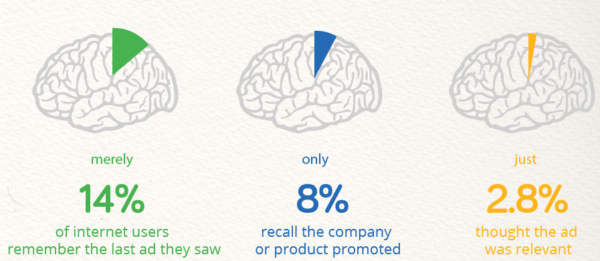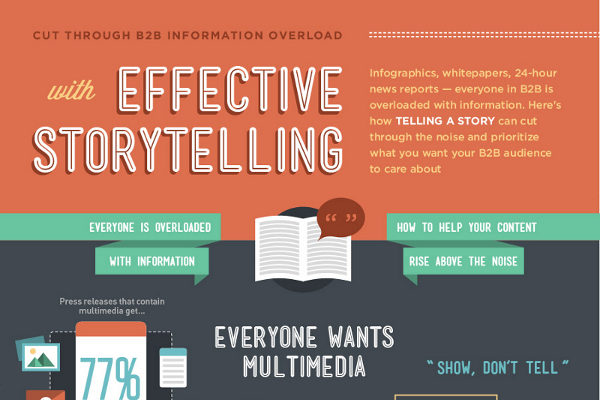Did you know that only around 8 percent of people will be able to recall an advertisement or banner that they saw online?
Banner blindness is a problem that has been plaguing digital marketers for quite a while. In fact, the average click-through-rate of banner ads is only 0.4 percent, down from 44 percent when the first banner ad appeared in 1994.
Storytelling is quickly becoming one of the most effective ways to reach consumers. In this article, we’ll explore the reasons why advertisers find that telling stories works much better than traditional ads.
1. Overcome Banner Blindness
What exactly is banner blindness? It is a term referring to the fact that many, if not most, consumers subconsciously block out online ads from their mental field of vision.
For example, when people search on Google, many have become accustomed to skip the first few paid search results and only pay attention to the organic search results.
This idea is reinforced by heatmap analytics that show that users aren’t paying attention to banner ads on websites.
This is besides the fact that many users simply use a browser extension to hide advertisements.
In other words: People don’t want to see ads, and when you run an ad, you automatically have to overcome consumers’ built-in “BS barriers” or defenses that they have built up to protect themselves from unwanted promotions and solicitations.
2. Make an Impression
As you can see, banners don’t make much of a lasting impression on 92 percent consumers, if they are noticed at all. However, a story can be more powerful.
A powerful story can stay embedded in the mind of a reader or viewer for a long time. With storytelling, you can become memorable.
3. Appeal to Emotions
With marketing, appealing to emotions is often more powerful than logic. Tony Robbins often talks about how you can use pain and pleasure to motivate yourself, but these two concepts are also important in marketing.
Pain and pleasure are the two most motivating factors or emotions that cause people to take any kind of action. Pain is more powerful than pleasure – people will do more to avoid immediate pain than to experience pleasure.
If you know your target base’s pain points, you can offer them the right solutions to help them.
Storytelling can make this more potent. You can tell stories of how your product or service has helped your customers overcome difficulties.
A great way to do this is to utilize video testimonials. Testimonials are powerful – people trust online reviews and testimonials as much as personal recommendations from family and friends.
Having video testimonials on your site where clients tell their stories of how your product or service has helped them can appeal to the emotions of your visitors.
4. Be Relatable
Advertisements are cold and aloof. It’s hard to make a personal connection with online users through search engine and banner ads.
However, stories can allow you to reach people in ways otherwise not possible. People feel that they can relate to a story that someone in a similar situation as they are in experienced.
5. Motivate People
A story can motivate people in ways a banner ad will never be able to. It can motivate people to take action that will change their life.
Let’s give an example. If you are selling health foods or juices to be used for dieting purposes, you can tell a story of how people have changed their lives, lost weight, and started living a healthier lifestyle with more energy with your products.
This can motivate people to take control of their own life much more than a banner ad promoting your product can.
6. Transform Beliefs
People have built-in beliefs about many things. However, by telling stories, you can change people’s ingrained beliefs.
For example, some people might have ingrained beliefs that losing weight would be impossible for them or would require going to the gym for hours each week, which they have no time for, or purchasing expensive supplements, which they can not afford.
However, by telling a story of how people managed to lose weight by following the diet plan in your ebook guide, which focuses on light exercise and avoiding weight-causing foods, you can change people’s perspectives and show them a whole new world.
7. Show Vs Tell
There’s a big difference between simply telling someone about something and visually demonstrating it to them.
Whether you are using videos to tell a story and visually demonstrating the benefits of your service to consumers or you are painting a mental image in their mind through the power of your words, a story is always more powerful.
Sales experts rely more on psychological ploys to incite sales these days.
8. Be Less Salesy
One of the reasons for banner blindness is that people don’t like to have things pushed on them.
With traditional ads, it’s hard not to be salesy; after all, the ads are promotional by nature, and you have to work hard to overcome that barrier.
Stories can reach people easier because consumers don’t have their defenses up like they do with ads.
Storytelling lets you sell your product or service while being subtle about it.
9. Keep People’s Attention
Overcoming banner blindness is just the first step. Even if you do catch people’s attention, can you keep it?
The average human attention span keeps getting smaller, thanks to the internet. Here are some stats that might surprise you:
- People don’t usually read more than 20-28 percent of words on a webpage
- Most people don’t spend more than a minute on a webpage they visit and often leave within 10-20 seconds
- If a video doesn’t captivate people within 10 seconds, they won’t watch it
If you are using traditional ads to direct people to a sales page, you have to work hard to get people’s attention.
Using stories is a great way to captivate people. Once you master the art of storytelling, you will be able to captivate your audience so that they stay with you until the end and listen to your entire subtle promotion.
10. Tap Into the Power of Metaphors
Metaphors can invoke powerful imagery and emotions and be used to make impressionable comparisons.
You can use metaphors to subtly imply that your product or service is something amazing or a unique idea.
Here are some examples of how metaphors were used in famous marketing campaigns:
- Tropicana used “Your Daily Ray of Sunshine” to promote orange juice and compare it to natural living, brightness, happiness, and vitality
- Werther’s used “It’s What Comfort Tastes Like” to promote chocolate
- Wheaties used “The Breakfast of Champions” to promote their cereal and invoke the idea that it will give you strength, energy, and vitality
11. Back Up Your Claims With Evidence
Storytelling allows you to back up your claims with data.
You can show proof of how people have been helped by your service or use statistics as evidence.
Storytelling also allows you to create social proof.
12. Evoke FOMO
Storytelling also allows you to evoke the emotion of fear – primarily, the fear of missing out (also known as FOMO).
Wrapping It Up
When telling stories, it is important to first know your target audience and what they are looking for.
This way, you can tell stories that appeal to them, capture their attention, and motivate them to take action.
Read more: It’s a New Ball Game: Social Media Versus Traditional Media



